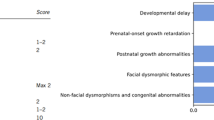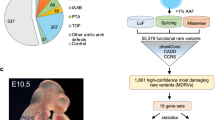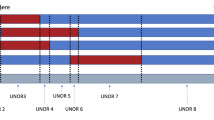Abstract
Although 22q11.2 deletion syndrome (22q11.2DS) is the most recurrent human microdeletion syndrome associated with a highly variable phenotype, little is known about the condition’s true incidence and the phenotype at diagnosis. We performed a multicenter, retrospective analysis of postnatally diagnosed patients recruited by members of the Association des Cytogénéticiens de Langue Française (the French-Speaking Cytogeneticists Association). Clinical and cytogenetic data on 749 cases diagnosed between 1995 and 2013 were collected by 31 French cytogenetics laboratories. The most frequent reasons for referral of postnatally diagnosed cases were a congenital heart defect (CHD, 48.6%), facial dysmorphism (49.7%) and developmental delay (40.7%). Since 2007 (the year in which array comparative genomic hybridization (aCGH) was introduced for the routine screening of patients with intellectual disability), almost all cases have been diagnosed using FISH (96.1%). Only 15 cases (all with an atypical phenotype) were diagnosed with aCGH; the deletion size ranged from 745 to 2904 kb. The deletion was inherited in 15.0% of cases and was of maternal origin in 85.5% of the latter. This is the largest yet documented cohort of patients with 22q11.2DS (the most commonly diagnosed microdeletion) from the same population. French cytogenetics laboratories diagnosed at least 108 affected patients (including fetuses) per year from among a national population of ∼66 million. As observed for prenatal diagnoses, CHDs were the most frequently detected malformation in postnatal diagnoses. The most common CHD in postnatal diagnoses was an isolated septal defect.
Similar content being viewed by others
Log in or create a free account to read this content
Gain free access to this article, as well as selected content from this journal and more on nature.com
or
References
Oskarsdottir S, Vujic M, Fasth A : Incidence and prevalence of the 22q11 deletion syndrome: a population-based study in Western Sweden. Arch Dis Child 2004; 89: 148–151.
Orphanet Prévalence des maladies rares: données bibliographiques Juin 2013 n°1. Data available from URL http://www.orpha.net/consor/cgi-bin/Education_Home.php?lng=FR.
Ryan AK, Goodship JA, Wilson DI et al: Spectrum of clinical features associated with interstitial chromosome 22q11 deletions: a European collaborative study. J Med Genet 1997; 34: 798–804.
Hay BN : Deletion 22q11: spectrum of associated disorders. Semin Pediatr Neurol 2007; 14: 136–139.
Monteiro FP, Vieira TP, Sgardioli IC et al: Defining new guidelines for screening the 22q11.2 deletion based on a clinical and dysmorphologic evaluation of 194 individuals and review of the literature. Eur J Pediat 2013; 172: 927–945.
Bassett AS, McDonald-McGinn DM, Devriendt K et al: Practical guidelines for managing patients with 22q11.2 deletion syndrome. J Pediatr 2011; 159: 332–339.
McDonald-McGinn DM, Emanuel BS, Zackai EH : 22q11.2 Deletion syndrome. In: Pagon RA, Adam MP, Bird TD, Dolan CR, Fong CT, Stephens K (eds): Gene Reviews, 1993.
Cancrini C, Puliafito P, Digilio MC et al: Clinical features and follow-up in patients with 22q11.2 deletion syndrome. J Pediatr 2014; 164: 1475–1480, e2.
Edelmann L, Pandita RK, Morrow BE : Low-copy repeats mediate the common 3-Mb deletion in patients with velo-cardio-facial syndrome. Am J Hum Genet 1999; 64: 1076–1086.
Besseau-Ayasse J, Violle-Poirsier C, Bazin A et al: A French collaborative survey of 272 fetuses with 22q11.2 deletion: ultrasound findings, fetal autopsies and pregnancy outcomes. Prenatal Diagn 2014; 34: 424–430.
Michaelovsky E, Frisch A, Carmel M et al: Genotype-phenotype correlation in 22q11.2 deletion syndrome. BMC Med Genet 2012; 13: 122.
Carlson C, Papolos D, Pandita RK et al: Molecular analysis of velo-cardio-facial syndrome patients with psychiatric disorders. Am J Hum Genet 1997; 60: 851–859.
Saitta SC, Harris SE, Gaeth AP et al: Aberrant interchromosomal exchanges are the predominant cause of the 22q11.2 deletion. Hum Mol Genet 2004; 13: 417–428.
Nogueira SI, Hacker AM, Bellucco FT et al: Atypical 22q11.2 deletion in a patient with DGS/VCFS spectrum. Eur J Hum Genet 2008; 51: 226–230.
Verhagen JM, Diderich KE, Oudesluijs G et al: Phenotypic variability of atypical 22q11.2 deletions not including TBX1. Am J Med Genet A 2012; 158A: 2412–2420.
Rauch A, Zink S, Zweier C et al: Systematic assessment of atypical deletions reveals genotype-phenotype correlation in 22q11.2. J Med Genet 2005; 42: 871–876.
Ben-Shachar S, Ou Z, Shaw CA et al: 22q11.2 distal deletion: a recurrent genomic disorder distinct from DiGeorge syndrome and velocardiofacial syndrome. Am J Hum Genet 2008; 82: 214–221.
Jerome LA, Papaioannou VE : DiGeorge syndrome phenotype in mice mutant for the T-box gene, Tbx1. Nat Genet 2001; 27: 286–291.
Mercher T, Coniat MB, Monni R et al: Involvement of a human gene related to the Drosophila spen gene in the recurrent t(1;22) translocation of acute megakaryocytic leukemia. Proc Natl Acad Sci USA 2001; 98: 5776–5779.
Paylor R, Lindsay E : Mouse models of 22q11 deletion syndrome. Biol Psychiatry 2006; 59: 1172–1179.
Yamagishi H, Garg V, Matsuoka R, Thomas T, Srivastava D : A molecular pathway revealing a genetic basis for human cardiac and craniofacial defects. Science 1999; 283: 1158–1161.
Olaopa M, Zhou HM, Snider P et al: Pax3 is essential for normal cardiac neural crest morphogenesis but is not required during migration nor outflow tract septation. Dev Biol 2011; 356: 308–322.
Guris DL, Fantes J, Tara D, Druker BJ, Imamoto A : Mice lacking the homologue of the human 22q11.2 gene CRKL phenocopy neurocristopathies of DiGeorge syndrome. Nat Genet 2001; 27: 293–298.
Dykes IM, van Bueren KL, Ashmore RJ et al: HIC2 is a novel dosage-dependent regulator of cardiac development located within the distal 22q11 deletion syndrome region. Circ Res 2014; 115: 23–31.
Fernandez L, Lapunzina P, Arjona D et al: Comparative study of three diagnostic approaches (FISH, STRs and MLPA) in 30 patients with 22q11.2 deletion syndrome. Clin Genet 2005; 68: 373–378.
Vialard F, Simoni G, Aboura A et al: Prenatal BACs-on-Beads: a new technology for rapid detection of aneuploidies and microdeletions in prenatal diagnosis. Prenatal Diagn 2011; 31: 500–508.
Le rapport médical et scientifique de l’Agence de la biomédecine 2010. Génétique postnale 2010. URL http://www.agence-biomedecine.fr/annexes/bilan2010/accueil.htm.
Le rapport médical et scientifique de l’Agence de la biomédecine 2011. Génétique postnatale 2011 et Génétique prénatale 2010. Data available from URL http://www.agence-biomedecine.fr/annexes/bilan2011/accueil.htm.
Le rapport médical et scientifique de l’Agence de la biomédecine 2012. Génétique postnatale 2012 et Génétique prénatale 2011. Data available from URL http://www.agence-biomedecine.fr/annexes/bilan2012/accueil.htm.
Le rapport médical et scientifique de l’Agence de la biomédecine 2013. Génétique prénatale 2012. URL http://www.agence-biomedecine.fr/annexes/bilan2013/donnees/diag-prenat/01-diag_prenat/synthese.htm.
Bassett AS, Chow EW, Husted J et al: Clinical features of 78 adults with 22q11 Deletion Syndrome. Am J Med Genet A 2005; 138: 307–313.
Bretelle F, Beyer L, Pellissier MC et al: Prenatal and postnatal diagnosis of 22q11.2 Deletion Syndrome. Eur J Med Genet 2010; 53: 367–370.
Repetto GM, Guzman ML, Puga A et al: Clinical features of chromosome 22q11.2 microdeletion syndrome in 208 Chilean patients. Clin Genet 2009; 76: 465–470.
Momma K : Cardiovascular anomalies associated with chromosome 22q11.2 deletion syndrome. Am J Cardiol 2010; 105: 1617–1624, Review.
Shprintzen RJ, Goldberg RB, Lewin ML et al: A new syndrome involving cleft palate, cardiac anomalies, typical facies, and learning disabilities: velo-cardio-facial syndrome. Cleft Palate J 1978; 15: 56–62.
Schneider M, Debbané M, Bassett AS et alInternational Consortium on Brain and Behavior in 22q11.2 Deletion Syndrome: Psychiatric disorders from childhood to adulthood in 22q11.2 deletion syndrome: results from the International Consortium on Brain and Behavior in 22q11.2 Deletion Syndrome. Am J Psychiatry 2014; 171: 627–639, Review.
Monks S, Niarchou M, Davies AR et al: Further evidence for high rates of schizophrenia in 22q11.2 deletion syndrome. Schizophr Res 2014; 153: 231–236.
Cohen E, Chow EW, Weksberg R, Bassett AS : Phenotype of adults with the 22q11 deletion syndrome: a review. Am J Med Genet 1999; 86: 359–365.
Desmaze C, Scambler P, Prieur M et al: Routine diagnosis of DiGeorge syndrome by fluorescent in situ hybridization. Hum Genet 1993; 90: 663–665.
Zeitz MJ, Lerner PP, Ay F et al: Implications of COMT long-range interactions on the phenotypic variability of 22q11.2 deletion syndrome. Nucleus 2013; 4: 487–493.
Bittel DC, Yu S, Newkirk H et al: Refining the 22q11.2 deletion breakpoints in DiGeorge syndrome by aCGH. Cytogenet Genome Res 2009; 124: 113–120.
Sacharow S, Li D, Fan YS, Tekin M : Familial 16q24.3 microdeletion involving ANKRD11 causes a KBG-like syndrome. Am J Med Genet A 2012; 158A: 547–552.
Costain G, Chow EW, Silversides CK, Bassett AS : Sex differences in reproductive fitness contribute to preferential maternal transmission of 22q11.2 deletions. J Med Genet 2011; 48: 819–824.
Sobin C, Kiley-Brabeck K, Monk SH, Khuri J, Karayiorgou M : Sex differences in the behavior of children with the 22q11 deletion syndrome. Psychiat Res 2009; 166: 24–34.
Niklasson L, Gillberg C : The neuropsychology of 22q11 deletion syndrome. A neuropsychiatric study of 100 individuals. Res Dev Disabil 2010; 31: 185–194.
Antshel KM, AbdulSabur N, Roizen N, Fremont W, Kates WR : Sex differences in cognitive functioning in velocardiofacial syndrome (VCFS). Dev Neuropsychol 2005; 28: 849–869.
Démographie – Nombre de naissances vivantes – France métropolitaine. Data available from URL http://www.insee.fr/fr/bases-de-donnees/bsweb/serie.asp?idbank=000436391.
Acknowledgements
We thank the members of the Association des Cytogénéticiens de Langue Française for their collaboration. The present work was funded by the French Ministry of Health (reference: DHOS 2007).
Author information
Authors and Affiliations
Corresponding author
Ethics declarations
Competing interests
The authors declare no conflict of interest.
Additional information
Supplementary Information accompanies this paper on European Journal of Human Genetics website
Rights and permissions
About this article
Cite this article
Poirsier, C., Besseau-Ayasse, J., Schluth-Bolard, C. et al. A French multicenter study of over 700 patients with 22q11 deletions diagnosed using FISH or aCGH. Eur J Hum Genet 24, 844–851 (2016). https://doi.org/10.1038/ejhg.2015.219
Received:
Revised:
Accepted:
Published:
Issue date:
DOI: https://doi.org/10.1038/ejhg.2015.219
This article is cited by
-
Clinical characterization of 72 patients with del(22)(q11.2q11.2) from different ethnic backgrounds
Egyptian Journal of Medical Human Genetics (2022)
-
Combined use of bacterial artificial chromosomes-on-beads with karyotype detection improves prenatal diagnosis
Molecular Cytogenetics (2019)
-
Testing criteria for 22q11.2 deletion syndrome: preliminary results of a low cost strategy for public health
Orphanet Journal of Rare Diseases (2019)
-
Clinical presentation and genetic profiles of Chinese patients with velocardiofacial syndrome in a large referral centre
Journal of Genetics (2019)
-
Genomic findings in patients with clinical suspicion of 22q11.2 deletion syndrome
Journal of Applied Genetics (2017)



